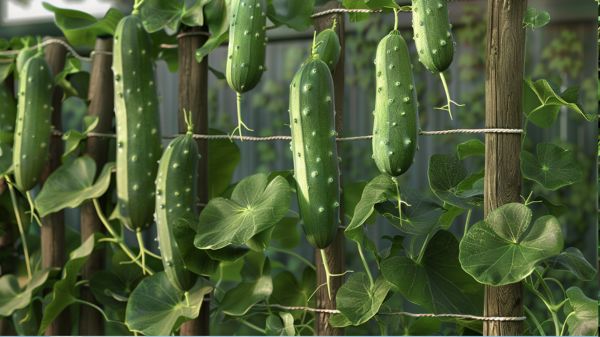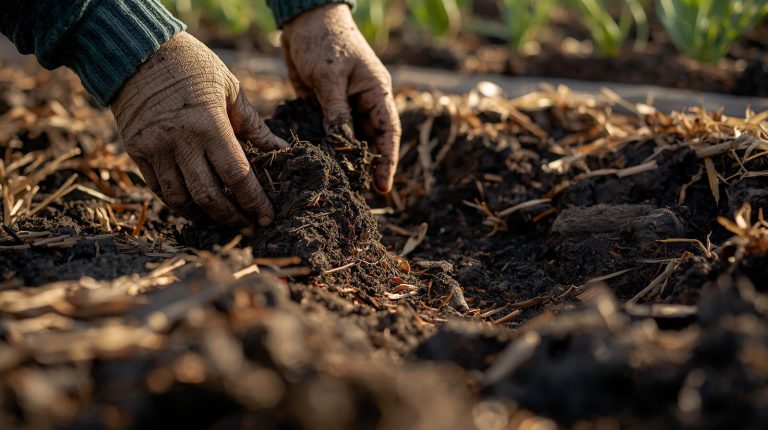To grow cucumbers vertically, start by selecting a sturdy trellis that supports the plant’s weight and promotes air circulation. Utilize alternative methods like bucket gardening or hydroponics system for space efficiency.
Plant cucumbers in a sunny spot with fertile soil, ensuring they receive 6-8 hours of sunlight daily and consistent watering. Train vines to climb the trellis, focusing energy on fruit production. Additionally, maintain proper spacing, prune regularly, and consider companion planting for best growth.
Implementing these techniques will help you grow cucumbers vertically successfully, enhancing your gardening experience.
Selecting Suitable Trellis Options
When considering suitable trellis options for growing cucumbers vertically, it is important to evaluate various factors such as structural integrity, space utilization, and cost-effectiveness to guarantee optimal support for the plants.
Trellis aesthetics play a significant role in enhancing the visual appeal of your garden while providing vertical gardening benefits such as increased sunlight exposure and improved air circulation for healthier cucumber plants.
Proper cucumber plant care, including soil preparation, watering, and regular maintenance, is essential to guarantee successful growth on the trellis.
DIY trellis options, such as using metal mesh sheets or string trellises, offer cost-effective alternatives for vertical gardening enthusiasts. Additionally, selecting the right cucumber variety, like Dasher II or Spacemaster, can impact the success of your vertical cucumber garden.
Exploring Alternative Growing Methods
To further expand the vertical growing potential of cucumbers, exploring alternative methods beyond traditional trellises can offer innovative solutions for maximizing space and enhancing cultivation efficiency.
- Bucket gardening presents an inventive approach, where cucumbers are grown upside-down in 5-gallon buckets, eliminating ground pests and weeds.
- Hanging planters provide another creative option, allowing cucumbers to thrive vertically while saving ground space.
- Vertical hydroponics offer a soil-less growing method, ideal for urban gardening trends, optimizing water usage and nutrient delivery.
- Creative containers such as recycled bottles or PVC pipes can serve as unique vessels for cucumber growth, adding a touch of sustainability to the cultivation process.
Embracing these alternative growing methods not only diversifies gardening practices but also aligns with modern urban gardening trends, promoting efficient space utilization and innovative solutions for home cultivation.
Implementing Proper Planting Techniques
Proper implementation of planting techniques is essential for maximizing cucumber growth and yield in vertical gardening setups.
- Vertical spacing: Adequate spacing between cucumber plants along the trellis guarantees proper airflow and sunlight exposure for each plant, promoting healthy growth.
- Sunlight exposure: Cucumbers require at least 6-8 hours of direct sunlight daily for best photosynthesis, fruit development, and overall plant health.
- Watering frequency: Consistent and thorough watering is critical, especially during hot and dry periods, to prevent dehydration and guarantee proper nutrient uptake.
- Trellis aesthetics: Choosing a trellis that complements the garden’s visual appeal can enhance the overall look of the vertical cucumber setup while providing structural support for the plants.
- Soil fertility: Fertile soil rich in nutrients supports vigorous growth and abundant fruit production. Amending the soil with compost or organic matter before planting can boost soil fertility, aiding in the development of healthy cucumber plants.
Understanding Soil and Fertilization Needs
Understanding the soil composition and fertilization requirements is fundamental for ensuring ideal nutrient uptake and growth for cucumber plants in vertical gardening systems.
Cucumbers thrive in loam or sandy soil enriched with nutrients, benefiting from mulching to retain moisture and suppress weeds. Fertilization techniques involving nitrogen, potassium, and phosphorus applications enhance crop yield, with additional fertilization in early summer and fall to maintain plant health and productivity.
Adequate sunlight exposure, proper plant spacing, and mulching with organic matter are essential for healthy cucumber growth. Vertical gardening offers benefits such as higher yields, reduced water consumption, decreased risk of diseases, and easier maintenance.
To optimize growth, plant cucumber varieties that suit vertical cultivation, consider the type of cucumber plant (vining or bush), provide a sunny and well-drained location, regularly water, fertilize, and harvest cucumbers promptly.
Training and Pruning Cucumber Vines
When training and pruning cucumber vines for best growth, strategic vine manipulation techniques play an important role in directing plant energy and maximizing fruit production.
- Training techniques: Tying vines to trellises or pergolas for support and vertical growth.
- Pruning benefits: Removing secondary vines to focus energy on main vines and fruiting areas.
- Trellis aesthetics, cost comparison: Selecting trellises based on structure, aesthetics, and cost to enhance vertical growth.
- Upside down cultivation, bucket advantages: Exploring upside-down growing in 5-gallon buckets to eliminate ground pests and weeds.
- Soil fertility, nutrient requirements: Ensuring fertile soil rich in nutrients and proper fertilization to support healthy cucumber growth.
Propagating Cucumbers for Expansion
To expand cucumber cultivation, propagating cucumber plants through seeds or stem cuttings is a vital practice for increasing yields and sustaining production. Utilizing propagation techniques offers numerous benefits, including the opportunity for creative gardening and innovation.
By propagating cucumbers vertically, gardeners can enhance efficiency in space utilization and promote the growth of different cucumber varieties suitable for vertical gardening. Selecting the right cucumber varieties plays an essential role in successful propagation, ensuring ideal growth and harvest.
Engaging in propagating cucumbers not only fosters personal garden love but also facilitates community outreach by sharing knowledge and resources with fellow gardeners. Embracing the art of propagation not only expands cucumber cultivation but also enriches the gardening experience through experimentation with various techniques and methods.
Choosing Ideal Growing Conditions
Selecting the appropriate growing conditions is paramount for cultivating healthy and productive cucumber plants in a vertical setting. When growing cucumbers vertically, the following factors play a vital role in ensuring successful cultivation:
- Pest management: Implementing pest control measures such as regular inspection, using natural repellents, and practicing crop rotation can help protect cucumber plants from common pests like aphids and cucumber beetles.
- Watering techniques: Providing consistent moisture through methods like drip irrigation or soaker hoses can help cucumbers thrive without the risk of overwatering or underwatering.
- Sunlight exposure: Cucumber plants require at least 6-8 hours of sunlight daily to facilitate photosynthesis and fruit development.
- Companion planting: Pairing cucumbers with beneficial companion plants like marigolds, radishes, or nasturtiums can help deter pests, improve soil health, and enhance overall growth.
- Soil preparation: Ensuring the soil is well-draining, nutrient-rich, and amended with organic matter like compost before planting is essential for supporting healthy root development and the best fruit production.
Utilizing Vertical Growing Techniques
Utilizing vertical growing techniques optimizes space and enhances productivity in cultivating cucumbers.
Vertical training involves tying plants to pergolas or trellises as they grow, ensuring efficient use of available space. Support systems, such as a 5-7 feet tall trellis secured into the ground or a raised bed, are essential for the plants to climb and thrive.
Proper spacing of cucumber plants along the trellis and regular pruning to control vines are important for successful vertical growth. Harvesting techniques are simplified with vertical growth, allowing for easier access to cucumbers as they mature.
Watering methods play an important role in vertical cucumber cultivation, ensuring that the plants receive adequate moisture for best growth. Pest control strategies are also significant to protect the plants from common cucumber pests that can hinder productivity. By implementing these techniques, gardeners can maximize their cucumber yield while efficiently utilizing space and resources.
Maximizing Benefits of Vertical Growth
In the domain of cultivating cucumbers through vertical growth techniques, maximizing the advantages of this approach involves strategically harnessing the benefits inherent in this method.
- Pest Management: Implementing vertical growth reduces the risk of ground pests and makes it easier to monitor and manage common cucumber pests like aphids or cucumber beetles.
- Water Conservation: Vertical growth promotes efficient water usage by directing water directly to the roots, reducing evaporation, and minimizing water wastage compared to traditional horizontal planting methods.
- Sunlight Exposure: By growing vertically, cucumbers receive ideal sunlight exposure throughout the day, leading to healthier plants, better fruit development, and increased photosynthesis.
- Harvesting Techniques: Vertical growth facilitates easier access to cucumbers, enabling quicker and cleaner harvesting, resulting in less damage to the plant and a more efficient harvesting process.
- Disease Prevention: Vertical growth aids in preventing soil-borne diseases by reducing soil splash onto the plants, enhancing air circulation, and promoting quicker drying of foliage, thereby minimizing the risk of diseases like powdery mildew.
Providing Support and Maintenance
To ensure healthy growth and maximum productivity of vertically cultivated cucumber plants, it is essential to provide sufficient support and maintenance throughout their development. Support techniques such as creating fabric slings or tying fruits onto trellises can help manage the challenge of heavy cucumber fruits on the vine.
Ensuring proper spacing for cucumber growth and adequate support is vital to prevent damage and promote healthier fruits. Maintenance tips include regular pruning to control vines, redirecting energy towards main vine and fruiting areas, and avoiding overcrowding for best growth.
Vertical benefits of growing cucumbers include higher yields, reduced water consumption, decreased risk of rot, diseases, and pests, as well as straighter and cleaner fruits.
Meeting growing requirements by choosing a 5-7 feet tall trellis, securing it properly, and training vines can enhance air circulation and facilitate easier companion planting. Vine training techniques like tying plants to pergolas or trellises with garden twine contribute to successful vertical cucumber cultivation.
Determining Space and Equipment Requirements
Determining the necessary space and equipment requirements is essential for successful vertical cucumber cultivation. When planning for your vertical cucumber garden, consider the following:
- Container Gardening: Opt for containers that suit your space and aesthetic preferences.
- Vertical Space: Utilize the height available efficiently for increased productivity.
- Creative Solutions: Explore innovative ways to maximize space and foster growth.
- Small Footprint: Make the most of limited space by choosing compact equipment and layouts.
- Equipment Options: Select appropriate tools and structures such as trellises, pergolas, or tomato cages to support your vertical cucumber garden effectively.
Building a Cucumber Trellis for Raised Beds
When constructing a cucumber trellis for raised beds, the design and placement of the support structure play a significant role in facilitating ideal growth and productivity for vertical cucumber cultivation.
Vertical gardening benefits are evident in higher yields, reduced water consumption, and improved air circulation, while raised bed advantages include better drainage and warmer soil for best plant growth.
When considering trellis design tips, it is crucial to make sure the support structure is at least 5 feet tall, securely placed in the back of the garden, and capable of accommodating the weight of mature vines.
Cucumber plant care involves providing fertile soil, ample water, and sunlight, along with regular pruning and training techniques for efficient growth.
Growing techniques explored include spacing and depth considerations based on cucumber varieties, as well as using trellises, garden netting, fences, or ladders to support vertical growth.
Going Vertical With Various Support Options
Vertical gardening enthusiasts can explore a variety of support options to maximize space and efficiency in cultivating cucumbers upwards.
- Vertical support: Utilize trellises, garden netting, fences, or ladders for vertical growth.
- Creative solutions: Experiment with innovative ways to train cucumber vines upwards.
- Sunlight optimization: Position trellises to guarantee cucumbers receive sufficient sunlight for peak growth.
- Efficient growth: Implement techniques like regular pruning and proper spacing to promote healthy vine development.
- Trellis aesthetics: Choose trellis designs that not only provide structural support but also enhance the visual appeal of the garden space.
Identifying Cucumber Varieties for Vertical Gardens
Exploring suitable cucumber varieties for vertical gardens involves identifying cultivars known for thriving in upward growing conditions and yielding best results.
When selecting cucumber varieties for vertical gardening, factors such as pest management, watering techniques, companion planting, soil preparation, and harvesting tips are vital for successful cultivation.
Varieties like Dasher II, known for their 8-9 inch length and quick 55-day growth period, or Spacemaster with a 60-day harvest time and approximately 7-inch length, are ideal choices. Ashley cucumbers, ready in 65 days, are suitable for shaded and humid areas.
Sweet Success, a seedless variety producing 12-14 inch cucumbers within 54 days, and Regal, yielding 10-inch fruits in 52 days, are also excellent options for vertical gardens.
Implementing proper pest management strategies, efficient watering techniques, companion planting with suitable crops, thorough soil preparation, and following recommended harvesting tips will guarantee a successful cucumber harvest in vertical garden settings.
Sharing Gardening Tips and Resources
To enhance your gardening experience and expand your knowledge, it is essential to share valuable gardening tips and resources with fellow enthusiasts.
- Container Gardening: Utilize containers for small-space gardening or to control soil conditions for best cucumber growth.
- Pest Management: Implement natural pest control methods such as neem oil or companion planting with marigolds to deter pests.
- Companion Planting: Grow cucumbers alongside herbs like basil or flowers like nasturtiums to enhance flavor and repel pests.
- Watering Techniques: Water cucumbers consistently, ensuring the soil is moist but not waterlogged to prevent root rot.
- Seasonal Pruning: Regularly prune cucumber plants to remove dead or damaged growth, enhancing air circulation and sunlight exposure for healthier fruits.
Exploring Different Types of Cucumber Plants
When considering the diversity of cucumber plants available for cultivation, it is important to explore the various types and their distinct characteristics to make informed choices for successful gardening endeavors.
Cucumber varieties come in two main types: bush cucumbers, which grow 2-3 feet and do not require a trellis, and vining cucumbers, which grow 4-6 feet or longer and can be grown either on the ground or up trellises.
Vining cucumbers tend to yield fewer misshapen fruits and are easier to harvest when grown vertically using vertical gardening techniques. DIY trellis options like metal mesh sheets, cattle panels, and string or netting trellises can be used for support.
Proper soil preparation is essential, including starting with fertile soil, training vines gently, and providing consistent moisture. Plant propagation can be done through seeds or stem cuttings, offering opportunities for expanding cucumber cultivation.
Embracing the Benefits of Using a Cucumber Trellis
Utilizing a cucumber trellis in cultivation practices offers a multitude of benefits for maximizing the growth and productivity of cucumber plants.
- Increased Yield: Growing cucumbers vertically can lead to a higher yield compared to traditional horizontal methods.
- Improved Plant Health: Vertical growth reduces the risk of rot, diseases, and pests due to better airflow and sunlight exposure.
- Space Efficiency: Trellises save garden space, making it easier to manage and harvest cucumbers.
- Straighter Fruits: Vertical growth results in straighter, cleaner, and more uniform cucumbers.
- Companion Planting: Trellises facilitate companion planting, allowing you to grow other vegetables or herbs alongside cucumbers for a mutually beneficial relationship.
Establishing Growing Conditions and Placement
How can ideal growing conditions and strategic placement positively impact the cultivation of cucumber plants?
Vertical gardening benefits cucumbers by maximizing space, sunlight exposure, and aiding in trellis aesthetics. To guarantee successful growth, select a sunny, wind-protected area with well-drained, fertile soil.
Implement plant training techniques by training vines vertically for efficient growth and fruit development. Consider using pergolas, trellises, teepees, arches, or A-frames for vertical gardening.
Proper soil fertility, including mulching for moisture retention, is essential for healthy cucumber plants. Regular pruning and redirecting energy towards the main vine and fruiting areas are critical for the best growth.
By choosing the right trellis and providing suitable growing conditions, such as rich soil and adequate sunlight exposure, you can enhance cucumber cultivation significantly.
Optimal placement and care ensure a bountiful harvest of straight, clean, and uniform cucumbers while reducing the risk of diseases and pests.
Exploring Various Types of Cucumber Trellises
Vertical gardening enthusiasts seeking to enhance their cucumber cultivation may find exploring the diverse range of cucumber trellises available to be a rewarding endeavor. When considering cucumber trellises, several factors come into play:
- Trellis aesthetics: Different trellis designs can add visual appeal to your garden while serving a practical purpose.
- Vertical support: Trellises provide the necessary support for cucumber vines to grow upwards, maximizing space and sunlight exposure.
- Cucumber growth: Choosing the right trellis can have a substantial impact on the growth and productivity of cucumber plants.
- DIY options: For those inclined towards hands-on projects, there are various DIY trellis options using materials like wood, string, or metal.
- Plant care techniques: Proper care practices, such as training vines on the trellis and providing adequate soil nutrients, are essential for healthy cucumber growth.
Exploring these aspects will not only enhance the efficiency of your cucumber cultivation but also contribute to the overall aesthetic appeal of your vertical garden.
DIY Trellis Ideas and Plant Care
What are some effective DIY trellis ideas and plant care practices for cultivating cucumbers vertically?
When it comes to vertical gardening tips for cucumbers, DIY trellis designs play a crucial role. Metal mesh sheets, cattle panels, and string or netting trellises are common options for supporting cucumber vines.
To guarantee healthy growth, provide cucumbers with rich soil, ample sunlight, consistent moisture, and regular inspections. Cucumber plant care is essential for best development.
Consider the growing conditions such as fertile soil, proper watering, and sunlight exposure. Cucumbers thrive in loam or sandy soil rich in nutrients, benefiting from mulching and fertilization.
When selecting a trellis, choose one that is at least 5 to 7 feet tall to support mature vines adequately. By spacing cucumber plants 12 inches apart along the trellis base and training the vines carefully, you can maximize space, airflow, and sunlight for a successful vertical cucumber garden.
Frequently Asked Questions
Can Cucumbers Be Grown Vertically Indoors or in a Greenhouse?
Cucumbers can be efficiently grown vertically indoors or in a greenhouse, benefiting from space optimization and enhanced sunlight exposure. Utilizing trellises or vertical structures allows for training vines, maximizing growth potential in controlled environments.
Are There Any Specific Pests or Diseases That Commonly Affect Vertically Grown Cucumbers?
Pest management and disease prevention are crucial for vertically grown cucumbers. Common issues include powdery mildew, cucumber beetles, and spider mites. Implementing proper vertical gardening techniques, regular inspection, and timely treatments are key for healthy cucumber plants.
How Can Trellising Cucumbers Impact the Flavor and Texture of the Fruits?
Trellising cucumbers can enhance flavor profiles by promoting better fruit development, resulting in crisper textures. Utilizing vertical growing techniques maximizes sunlight exposure, air circulation, and space efficiency, all contributing to superior cucumber quality.
Are There Any Unique Challenges or Considerations When Growing Cucumbers Vertically in a Humid Climate?
When growing cucumbers vertically in a humid climate, consider efficient watering techniques, ample sunlight, well-draining soil, durable trellis materials like metal or wood, and regular pruning methods to promote airflow and prevent disease in your cucumber plants.
Can Cucumbers Be Grown Vertically Alongside Other Companion Plants to Maximize Space Efficiency in the Garden?
Vertical gardening maximizes space efficiency by pairing cucumbers with compatible companions. Careful selection and strategic placement of plants optimize resources. Incorporating companion plants enhances biodiversity, deters pests, and promotes healthy growth. Implementing proper growing techniques guarantees successful harvests.
Conclusion
To sum up, growing cucumbers vertically offers a practical and efficient solution for maximizing space and enhancing plant growth. By implementing proper trellising techniques, selecting suitable varieties, and providing adequate care, gardeners can benefit from increased yields, reduced disease risks, and easier maintenance.
Embracing the advantages of vertical growth can lead to flourishing cucumber plants and a successful gardening experience. Explore innovative trellis options, understand plant needs, and enjoy the rewards of vertical cucumber gardening.




